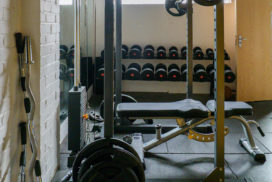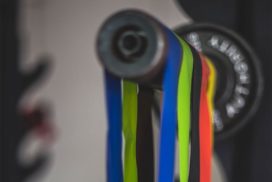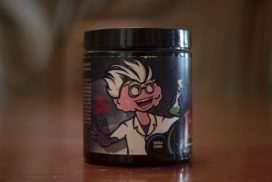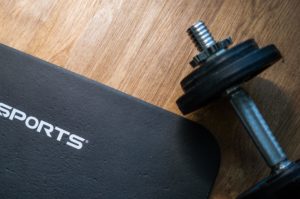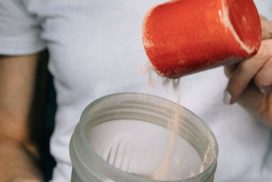DOMS, or ‘delayed onset muscle soreness’, is the soreness that you feel in your muscles after training. DOMS mostly occurs from eccentric activity. This is because the lengthening of a muscle under resistance damages muscle fibers. This damage can vary in its severity and manifests itself in soreness following the days after a workout.
DOMS mostly results from performing new exercises or training again after time off. This is because when your muscles are used more than is normal, the fibres develop miniature tears from the mechanical tension during resistance training.
Wether or not you should workout while sore comes down to if the muscle soreness is bad enough that it impacts your ability to perform exercises with good form and full range of motion.
If you are able to go through the movements while fully contracting the muscle and putting it through the entire range of motion, then it is best to go to the gym and train. Even though it may be uncomfortable it is better to stick to your split and continue to workout than take an unnecessary day off.
If you do not find you are able to contract the muscle fully due to stiffness or the level of pain from the DOMS, either stay home and do not train or go and train a day ahead and return to the workout you would have done when the DOMS becomes less intense.
Joint Pain vs. DOMS
If the pain you are experiencing after a workout is joint pain, not muscle soreness, then you should not train. Regardless of the severity of the pain, exacerbating joint injuries will limit your ability to workout at all so any sort of pain not related to the muscle should be taken seriously.
You can tell if the pain you are feeling is DOMS or joint pain by wether the muscle feels “tight” and burns from contraction, or if there is a sharp, acute pain from moving that muscle.
If the pain is sharp and is concentrated on one specific area, that is more likely an injury, not muscle soreness from training. An injury should be treated entirely differently than DOMS and is worth postponing a training session for the joint to heal.
Does Working Out With DOMS Worsen Muscle Soreness?
Assuming that the soreness you feel is from damaged muscle fibres not your joints, it is better to workout. Working out with muscle soreness has not been found to increase DOMS or negatively impact recovery.
This study on repeated eccentric exercise found that working out with sore muscles does not affect the recovery of those muscles or worsen the damage that’s already been done from earlier workouts.
Another study done on strenuous exercise performed 3 days apart found a similar result. It was able to determine that there was no negative effect on recovery or muscle damage from training with sore muscles regardless of the intensity of the training session. A third study also came to this conclusion.
Regardless of the volume, intensity, and which muscles are trained during the second workout, the recovery and muscle growth from the first workout that initially caused DOMS is not lessened by training using the sore muscles.
Ways To Reduce DOMS
Even though being sore does not have any negative impacts on your ability to train or recover from exercise, it can still affect your form if it is severe and is uncomfortable to many people. There are several ways to reduce muscle soreness. One way to reduce DOMS from training is to train more consistently.
This study found that working out lightly 2 days before a heavy workout reduced the DOMS from the heavier workout. A second study on muscle damage from bench pressing found that muscle soreness and muscle damage both decreased after the second session of bench press.
By sticking to a routine and program, over time the amount of muscle soreness will begin to subside. This is because your muscles will adapt to the demands of training and become more capable of performing the movements in your workouts.
Another way to reduce DOMS is to stretch, foam roll, and warmup before your next workout.
Stretching and foam rolling help to loosen up the muscles and increase blood flow. By improving blood flow and loosening the sore muscles, more oxygen and nutrients can be shuttled to them for repair.
It is also good to warm up directly before training by doing dynamic stretches and performing exercises with light weight before the working sets.
Additionally, sufficient protein intake and sleep both will help the muscle recover faster. If protein synthesis is allowed to fully occur and is facilitated by adequate protein intake, muscle soreness will be reduced much quicker than if you don’t supply the muscles with protein and amino acids from a good diet. The amount of protein you need as a weightlifter is around .8-1.2g of protein per pound of bodyweight. The optimal amount of sleep is 7-9 hours depending on your age.
Doing light exercise like jogging and jump roping can also help recovery by elevating your heart rate and boosting blood flow to the muscles that are sore.
Summary
Generally, in most cases you should still lift with DOMS. Muscle soreness has not found to have a negative effect on recovery or level of soreness so there is no reason to skip your workout as long you can complete all the exercises with good form.
If the muscle soreness is so bad that you are unable to fully contract the muscle and go through the range of motion required by an exercise then it is better not to train. You can still workout, just do the workout for the day ahead and train the muscles which are not sore.
In order to speed up muscle recovery and reduce DOMS from working out, train consistently, stretch, foam roll, warm up before your workouts, get adequate sleep, and make sure your diet has enough protein.
If your soreness is related to a joint, not your muscles, then do not workout at all. Joint pain is more acute and sharp, muscle soreness is more stiff and tight. If you are unsure, see how it feels to contract the muscle. If there is a burn during contraction then it is muscle soreness, if there is pain in one specific spot then it may be a problem with the joint. Joint pain should be treated seriously and if it persists, see a doctor.
For more on training and recovery, such as how you can improve your training performance from nasal breathing and the benefits of mobility training for lifting, click here.


